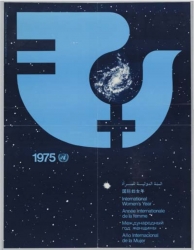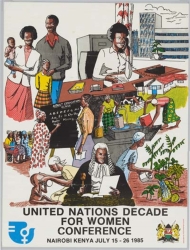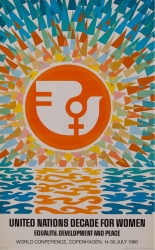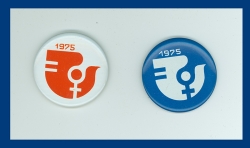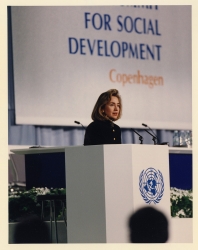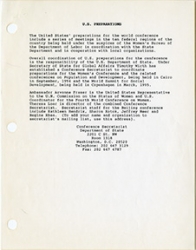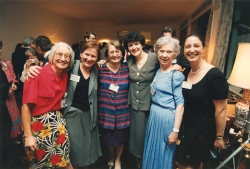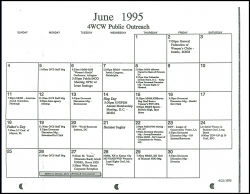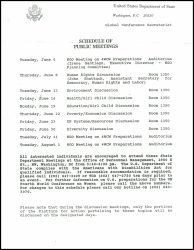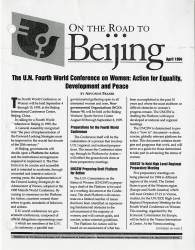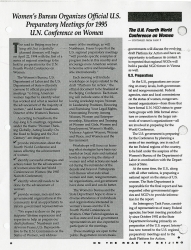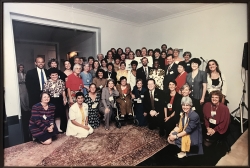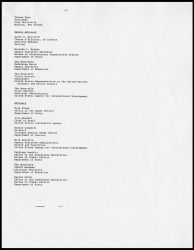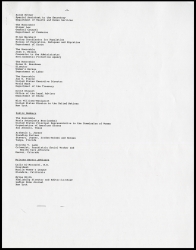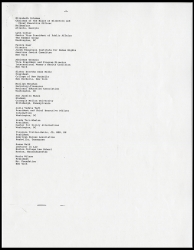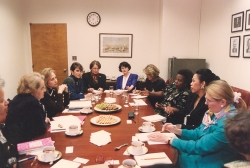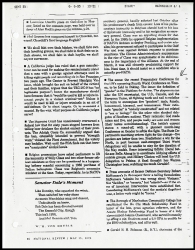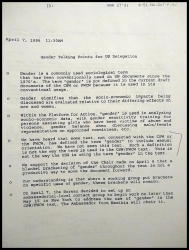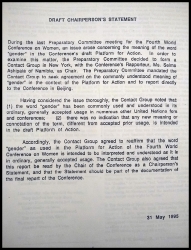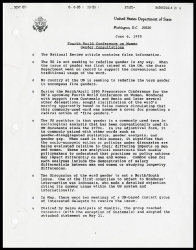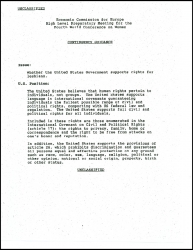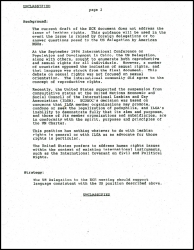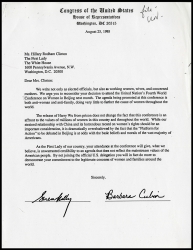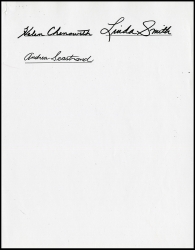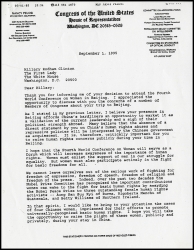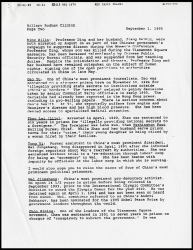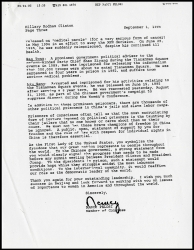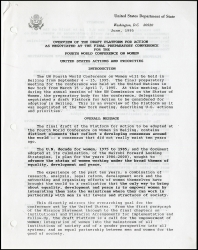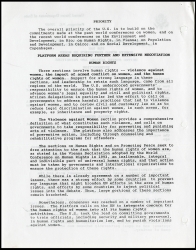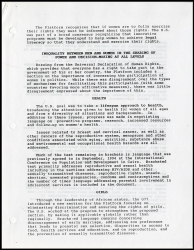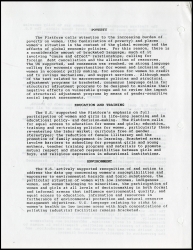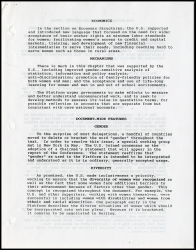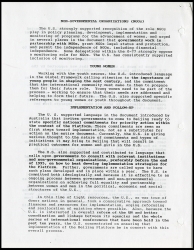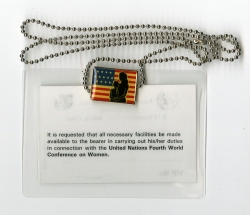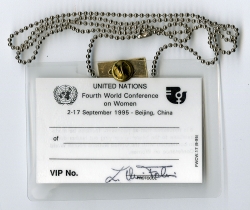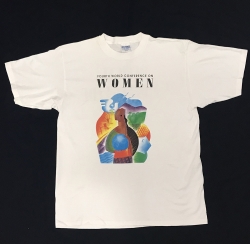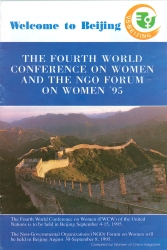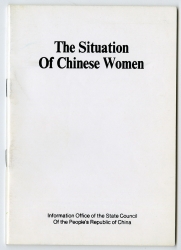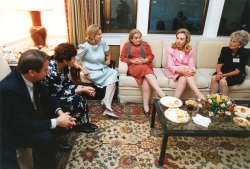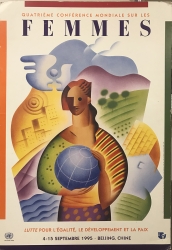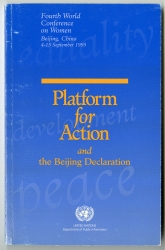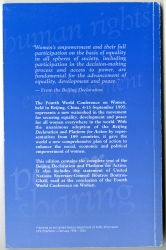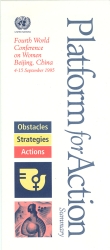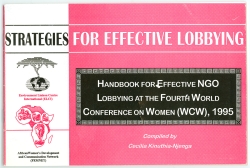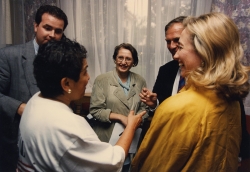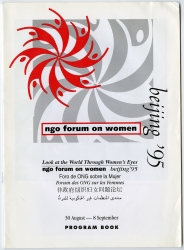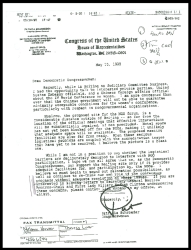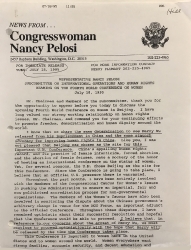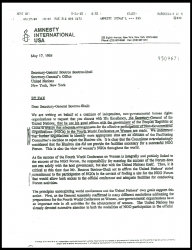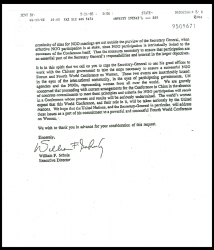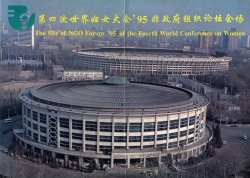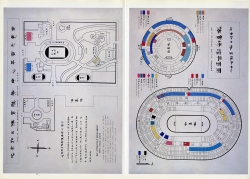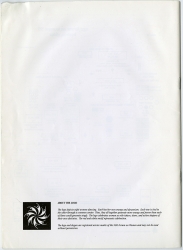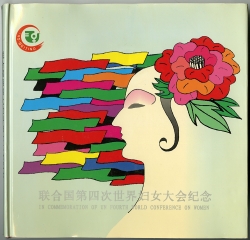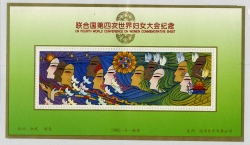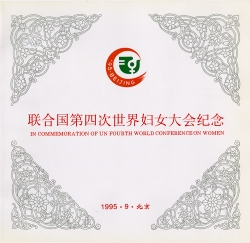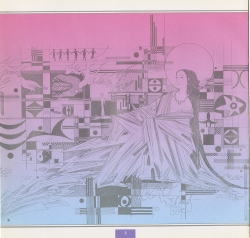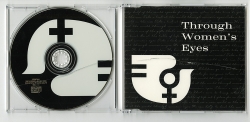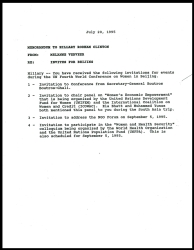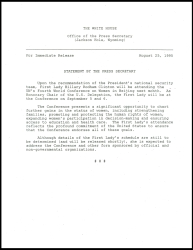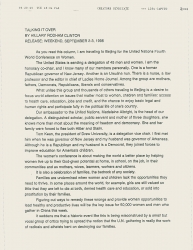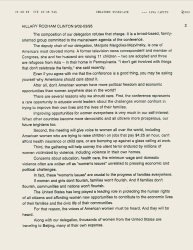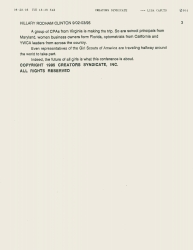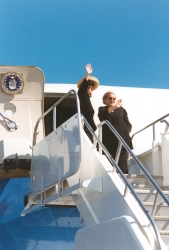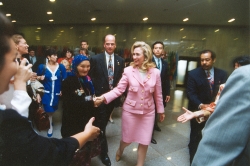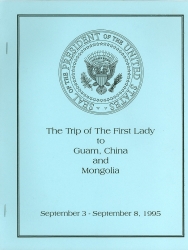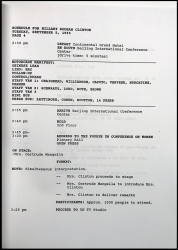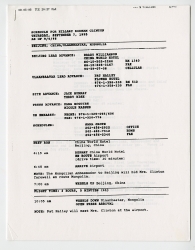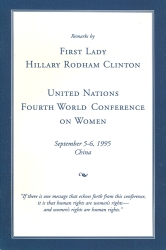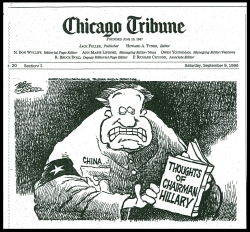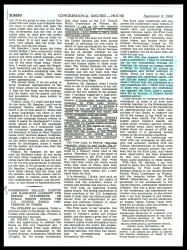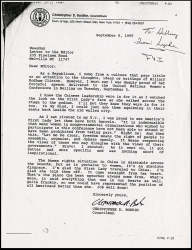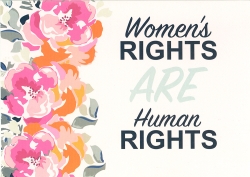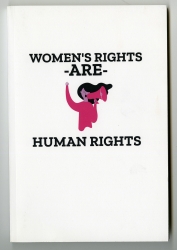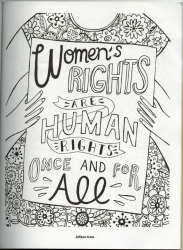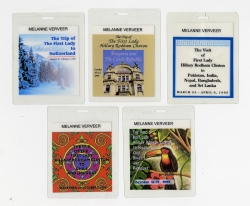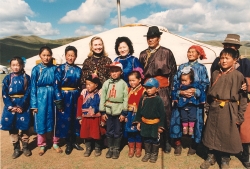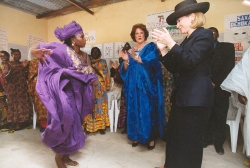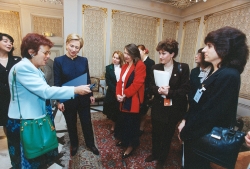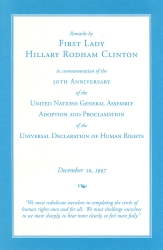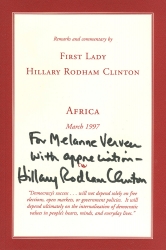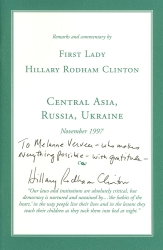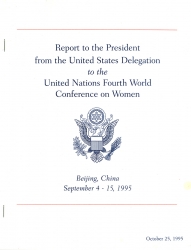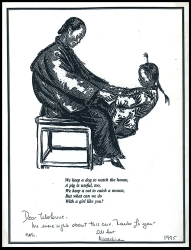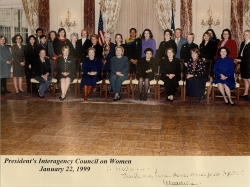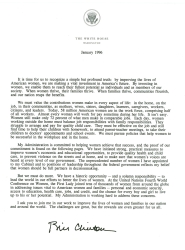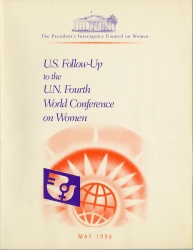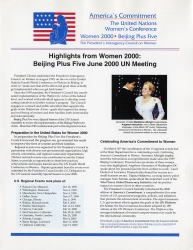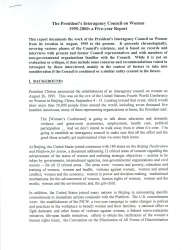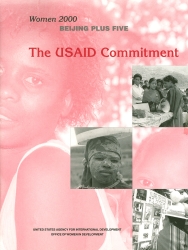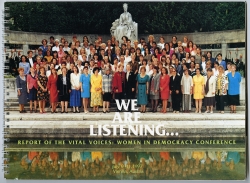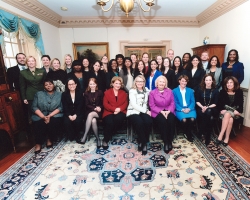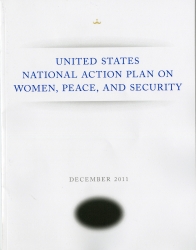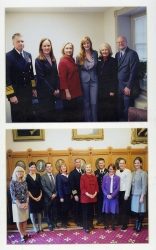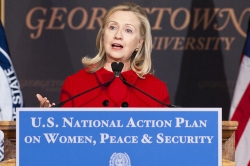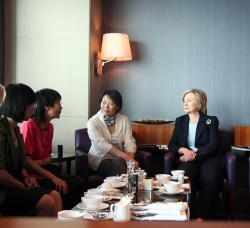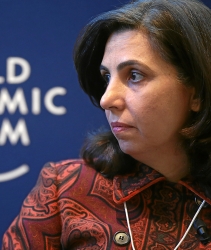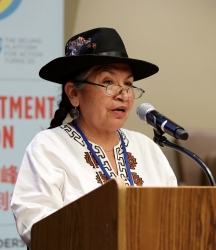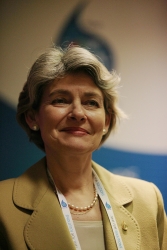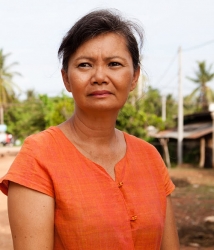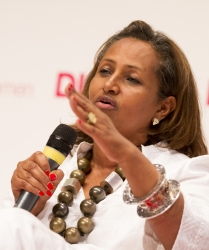“If there is one message that echoes forth from this conference, let it be that women’s rights are human rights, and human rights are women’s rights, once and for all.”
The United Nations Fourth World Conference on Women, hosted in Beijing in 1995, was one of the largest multilateral events ever convened. It welcomed 6,000 official delegates representing almost every country in the world, 4,000 members of the press, countless observers and civil servants, and more than 30,000 civil society leaders and activists at a parallel NGO Forum. The 189 participating nations signed on to a Declaration that remains the most ambitious international commitment to gender equality. Following the conference, attendees “brought Beijing home,” creating new NGOs, reinvigorating local women’s movements, running for office, and launching a cascade of legal reforms across the globe.
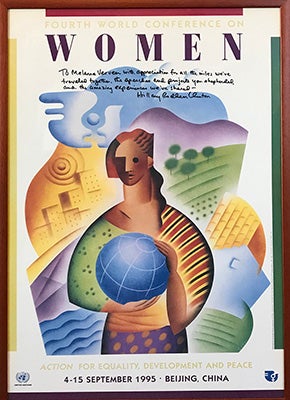 The ripple effects generated by the Beijing Conference had a significant impact on U.S. foreign policy. Preparation for the conference engaged a cross-section of citizens, and convened an official delegation that looked like America. Hillary Clinton’s visionary speech brought a wave of support from unexpected allies, and helped build a bi-partisan constituency committed to advancing global women’s issues. In its aftermath, new offices, programs, funding streams, and political support elevated the issue of equality on the foreign policy agenda. The legacy of these changes can still be seen today, in institutions and policies such as the White House Gender Policy Council; the State Department Office of Global Women’s Issues; and the Women, Peace and Security Act.
The ripple effects generated by the Beijing Conference had a significant impact on U.S. foreign policy. Preparation for the conference engaged a cross-section of citizens, and convened an official delegation that looked like America. Hillary Clinton’s visionary speech brought a wave of support from unexpected allies, and helped build a bi-partisan constituency committed to advancing global women’s issues. In its aftermath, new offices, programs, funding streams, and political support elevated the issue of equality on the foreign policy agenda. The legacy of these changes can still be seen today, in institutions and policies such as the White House Gender Policy Council; the State Department Office of Global Women’s Issues; and the Women, Peace and Security Act.
Beijing was a watershed moment in the history of women’s rights. This exhibition explores how the United States prepared for and participated in this historic event, and its echoes in U.S. diplomacy, defense, and development efforts. It draws on memos, posters, brochures, souvenirs, letters, and photographs from the archives of Ambassador Melanne Verveer—the first Ambassador-at-large for Global Women’s Issues, and Chief of Staff to First Lady Hillary Clinton—and other members of the U.S. delegation to the Beijing conference.
The Georgetown University Library would like to thank Ambassador Verveer for her generous donation of many of these exhibition items and other materials to the Library's Booth Family Center for Special Collections. This remarkable collection will be made accessible for research, instruction, and public programs.
(Image: NGO Forum Poster. Illustration by Coco Masuda, design by DPI Design Section. Published by the U.N. Department of Public Information, November 1994.)
Preparation
Preparing for the U.N. Fourth World Conference on Women was an opportunity to spotlight women’s issues at home. The official U.S. delegation reflected a wide cross section of America’s women—with representatives of all regions, professions, races, and ages—who joined bi-partisan congressional envoys. The State Department conducted extensive outreach, hosting meetings in Washington and across the country so women’s groups and civil society organizations could provide input on what America’s priorities should be. They faced some political controversies in preparing a unified platform, including disagreements over issues of the definition of gender, LGBT rights, and U.S.-China relations.
History
Poster Reproductions from Previous World Conference on Women Meetings: The Beijing Conference built on momentum from previous United Nations convenings. Between 1975 and 1985, the U.N. hosted three World Conferences on Women, and women’s rights increasingly became part of broader human rights conversations at the 1993 World Conference on Human Rights in Vienna and the 1994 International Conference on Population and Development in Cairo. This progress was codified at Beijing, by far the largest gathering to focus on women. To this day The Beijing Declaration represents a high-water mark for international commitments to women’s rights.
Official Lapel Pins from 1975 Mexico City Conference: These pins were produced for the First World Conference on Women, hosted in Mexico City in June 1975 and attended by 8,000 people. The Mexico City conference launched many of the networks that would reconvene over the next decades. On loan from Rebecca Turkington.
Hillary Rodham Clinton Speaking at the World Summit for Social Development: First Lady Hillary Clinton spoke at the 1995 World Summit for Social Development in Copenhagen, Denmark, just months before traveling to Beijing. In her remarks, she emphasized “the vital role that girls and women play in the economic, social, and political life of our societies.”
U.S. State Department Preparation
State Department Release Announcing Beijing Preparatory Committee: A year in advance, the White House announced its preparatory plans for the Fourth World Conference on Women. The Global Conference Secretariat, housed at the Department of State, would lead coordination for Beijing, as well as upcoming conferences on development.
Global Conference Secretariat Team: Members of the Global Conference Secretariat team—from the State Department and the First Lady’s office—pose in Beijing, after months of hard work.
National Outreach
State Department Calendar of Public Outreach: State Department officials worked to engage a wide spectrum of civil society in the consultative process around developing the U.S. negotiating position. A calendar of public outreach efforts for the Conference shows staff traveling to California, Florida, Pennsylvania, Missouri, and Washington state to bring the platform's principles to the broader American public and seek input from a diverse range of organizations.
Schedule of Public Meetings: The State Department also convened public meetings at its Washington, D.C. headquarters, open to those who wished to contribute the draft U.S. platform. Meeting topics ranged from education and poverty to U.N. bureaucracy.
On The Road to Beijing, April 1994: A periodical included regular updates on conference developments, guest contributions from leading American women, and information on the primary issues that would be included in the Beijing Platform for Action.
U.S. Delegation
The U.S. Delegation to the Fourth World Conference on Women: In choosing delegates to represent the United States, the Secretariat balanced geography, race, religion, occupation, and political leanings. A bipartisan Congressional delegation joined the official delegation: Representatives Maloney (D-NY), Harman (D-CA), Morella (R-MD), and Smith (R-NJ). Close to 8,000 U.S. citizens attended in their own capacity, as civil society representatives to the Huairou NGO Forum.
List of U.S. Delegates: U.S. Ambassador to the United Nations and future U.S. Secretary of State Madeleine K. Albright chaired the delegation. Members included Health and Human Services Secretary Donna Shalala, former Vice Presidential candidate Geraldine Ferraro, and disability rights activist and Assistant Secretary of Education Judith (Judy) Heumann.
Planning
Meeting with U.N. Planning Team: The U.S. Global Conference Secretariat team, led by Ambassador Madeleine Albright and First Lady Hillary Clinton, meets with the United Nations planning team, led by Secretary-General of the Conference Gertrude Mongella, to accelerate conference preparation.
The Politics of Gender
The National Review, May 15, 1995: A critical vignette in the National Review ridicules the debate over the term “gender” in the draft Platform for Action. “The State Department’s marching orders: fight for the change—five genders are better than two.”
Memo on Gender Consultation, June 6, 1995
Gender Talking Points for the U.S. Delegation, April 7, 1995
Draft Chairperson’s Statement on “Gender,” May 31, 1995
The definition of “gender” was a point of contention in 1994, just as it is today. The National Review article set off enough controversy for the State Department to specifically refute it—noting in this draft statement that the word was “a commonly used term in sociological analysis that has been conventionally used in U.N. documents since the 1970’s,” and that no U.N. member was seeking to redefine it. A U.N. group formed to consider the issue affirmed the use of "gender" in conference documents.
LGBT+ Rights
Contingency Guidance on Lesbian Rights – Fax Cover Sheet from the Conference Secretariat to Melanne Verveer, October 14, 1994
U.S. Position on Lesbian Rights
The Beijing Conference had a mixed record on LGBT+ issues. The final declaration did not include language on “sexual orientation,” though many activists had fought for it—even convening a protest in the conference hall at which two women were arrested. However, the Conference did feature South African activist Beverley Ditsie, the first openly lesbian woman to address the UN, and began a conversation in which LGBT+ concerns were formally discussed within a human rights framework. This contingency guidance outlines talking points on the official U.S. position "on lesbian rights."
Hillary Clinton’s Attendance in China
Letter from Barbara Cubin and Sue Kelly to Hillary Clinton, August 25, 1995
Letter from Nancy Pelosi to Hillary Clinton, September 1, 1995
The decision to send a high-level delegation to the Beijing Conference had critics on both the right and the left. Congresswomen Barbara Cubin (R-WY) and Sue Kelly (R-NY) warned Clinton in an August 25, 1995 letter that her attendance would grant “unwarranted credibility to an agenda that does not reflect the mainstream values of the American people.” On the other side of the aisle, Congresswoman Nancy Pelosi (D-CA) agreed in her September 1, 1995 letter that Clinton’s “presence affords China's hardliners an opportunity to market it as a validation of the current leadership…”
Final Draft Platform for Action
In March and April, final preparatory meetings took place at the UN Commission on the Status of Women to hammer out a draft Platform for Action to be adopted during the Beijing Conference. Some of the most controversial text was left bracketed—to be debated in Beijing. The document outlines the U.S. priorities for the Beijing negotiations. It emphasizes that “the only way to bring about equality, development and peace is to empower women by integrating them into the mainstream where they can work in partnership with men in all levels and structures of society.”
The Conference
The Fourth World Conference on Women was the largest U.N. conference in history, convening more than 6,000 official delegates from almost every country in the world (only Saudi Arabia, Granada, Somalia, and Yugoslavia did not participate). Over twelve days, participants developed a unified Declaration and Platform of Action that laid out an ambitious vision and concrete commitments for achieving equality. The Chinese government made the decision to house the NGO Forum in the town of Huairou, thirty-five miles outside Beijing. More than 30,000 activists showed up—sharing tactics and stories that inspired a renewed wave of global organizing.
U.S. Delegation Pin, Card and T-Shirt
U.S. Delegation Pin and Card: This laminated delegate card provided its bearer access to the conference venue and “all necessary facilities.” The pin, made especially for the U.S. delegation, features the silhouette of a woman and girl against a modified flag.
U.S. Delegation T-Shirt: This t-shirt was provided to conference delegates when they arrived in China.
Arrival
Welcome Brochure: Conference attendees were welcomed with a short informational brochure compiled by Women of China, a magazine published by the All-China Women’s Federation, China’s state-sponsored NGO for women’s rights.
Map of Beijing: Handwritten annotations by the First Lady's Chief of Staff Melanne Verveer on this map of downtown Beijing indicate the location of the conference plenary session; the hotels where the White House team, other members of the U.S. Delegation, and NGO representatives were staying; and the Great Hall of the People, a state building on Tiananmen Square where the conference opening ceremony would be held.
"The Situation of Chinese Women" Informational Brochure: Alongside logistics materials, guests received informational brochures about China’s own efforts to improve the status of women. The publications provide a optimistic view of women’s lives—lauding high levels of economic participation and education thanks to Communism—and describe Chinese government programs to implement goals developed at the previous world conference on women, hosted in Nairobi, Kenya in 1985.
The Venue
On the floor of the Plenary Room: Melanne Verveer leans in to speak with Leia Maria Boutros-Ghali, the wife of UN Secretary-General Boutros Boutros-Ghali, as she and Clinton listen to a panel discussion on women’s health.
Congressional Delegation: U.S. Delegation co-chairs Albright and Clinton speak with the bipartisan congressional delegation prior to Clinton’s plenary speech.
Speechwriters: Clinton speaks with staff on the morning of her keynote speech, including Melanne Verveer and Lissa Muscatine, her speechwriter.
Posters and Documents
NGO Forum Poster (French translation): By all accounts, the Huairou Forum was chaos: hundreds of events planned simultaneously, last-minute venue changes, and inclement weather. But many attendees reported that it was a defining moment in their careers. Designated tents for disabled women, indigenous women, older women, refugees, youth, and LGBTQ women built critical transnational friendships and networks, and helped launch a new wave of global activism. Poster on loan from Theresa Loar.
Official Beijing Declaration: Signed by 189 countries, the Beijing Declaration remains, to this day, the high-water mark in international commitments to women’s equality. The declaration affirmed that “Women's empowerment and their full participation on the basis of equality in all spheres of society, including participation in the decision-making process and access to power, are fundamental for the achievement of equality, development and peace,” and—in what became a rallying cry of the conference—“women’s rights are human rights.”
Official Beijing Platform for Action: The Beijing Platform for Action outlines well over 100 pages of an ambitious global agenda to advance equality through twelve strategic objectives: poverty; education and training; health; violence against women; armed conflict; the economy; power and decision-making; institutional mechanisms; human rights of women; the media; the environment; and the girl child. It sets clear benchmarks for governments. Many were later incorporated into the Millennium Development Goals. Many have yet to be met 26 years later.
The Huairou Forum
Strategies for Effective Lobbying Brochure: FEMNET—a pan-African feminist network—developed this "Strategies for Effective Lobbying" brochure to aid NGO participants in lobbying their national delegations during the forum. Beijing was the first global conference where email was widely used, and the brochure’s guidance included how to access digital resources developed for the conference. A computer center on the Huairou premises, staffed entirely by women, helped hundreds of attendees sign up for an email address for the first time.
Arriving in Huairou: In addition to her explosive speech at the conference plenary, the First Lady made the hour-long drive to Huairou to address NGO activists. In this photo, she has just arrived at the venue during a pouring rain storm with Donna Shalala and Melanne Verveer.
Official NGO Forum Program Book: The official program includes the schedule of activities planned for the Huairou Forum.On loan from Theresa Loar.
Forum Venue Controversy
Letter from Representative Patricia Schroeder, May 10, 1995
News Release from the Office of Representative Nancy Pelosi, July 18, 1995
Letter from Amnesty International Executive Director William F. Schulz, May 17, 1995
The Chinese government's decision to move the NGO Forum to Huairou, more than an hour’s drive from the downtown conference, worried many participants and drew heavy criticism. In these communications, U.S. Congresswomen Schroeder and Pelosi express concerns over the venue change, and Amnesty International formally registers a complaint with the U.N. Secretary General.
Bilingual Map of the Beijing Workers’ Sports Service Center: The Beijing Workers’ Sports Service Center was the original planned location for the NGO Forum in downtown Beijing. In March, the Chinese Organizing Committee announced the venue was structurally unsound, leading to a months-long, ultimately unsuccessful lobbying effort to keep the stadium space. According to press reports, organizers ultimately agreed to the move because the Chinese government offered to increase the participant cap from 20,000 to 36,000.
Opening Ceremony
Huairou Opening Ceremony Program: The description of the logo on the back of this NGO Forum program explains: “The logo depicts eight women dancing. Each has her own energy and dynamism. Each one is tied to the other through a common center. Thus, they all together generate more energy and power than each of them could generate singly. The logo celebrates women and risk-takers, doers, and active shapers of their own destinies. The red and white motif represents celebration.” On loan from Theresa Loar.
Commemorative Philatelic Album: Designed by Yan bing wu, Issued by the Beijing East District Stamp Company, 1995. This commemorative album includes sixteen pages of Chinese stamps and first day of issue cards. The text reads: “Chinese government is greatly concerned with improvement of women’s status and has achieved great success that attracts worldwide attention. In China’s opening to the outside world and social construction, the people’s government is much more concerned with woman’s work by encouraging and supporting women to participate in development, actively helping women improve their quality, practically solving women’s problems, protecting women’s legal rights, promoting the equality between man and woman and trying to make all these efforts to reflect women’s features of the age.” On loan from Theresa Loar.
Through Women's Eyes Music CD: Singer-songwriter Rosemary Loar wrote “Take a Look (Through Women’s Eyes)” for the Huairou Forum opening ceremony. A CD was produced to raise money for the Virginia Gildersleeve International Fund—a foundation committed to women’s empowerment, named for the only female U.S. delegate at the 1945 United Nations Conference on International Organization. On loan from Theresa Loar.
The Speech
Hillary Clinton’s stirring plenary speech became one of the defining moments of the conference, and of her time as First Lady. Clinton’s role leading the U.S. delegation was decried from both sides of the aisle, but once her speech was broadcast across the globe, letters poured in with praise from the most unlikely corners. The phrase “women’s rights are human rights” was pioneered by activists, and Clinton’s speech cemented it as a rallying cry for Beijing. Her words have lived long beyond the conference. Clinton’s leadership on global women’s issues characterized the rest of her tenure as First Lady. She built on the momentum of the conference creating the Vital Voices Democracy Initiative to promote women’s advancement through U.S. foreign policy, and repeated the tenets of her Beijing remarks in speeches across the globe.
Invitations
Invitation from U.N. Secretary-General: U.N. Secretary-General Boutros Boutros-Ghali invites Clinton to attend the conference as his special guest, noting the conference would benefit from “the prestige and respect which you command.”
Cover Sheet for U.N. Secretary-General Invitation: A July 20, 1995 memo from Melanne Verveer outlines the major speaking invitations Clinton has received, including: an address to the NGO Forum in Huairou; chairing a panel convened by Ela Bhatt, founder of the Self-Employed Women’s Association in India, and Muhammad Yunus, founder of Grameen Bank in Bangladesh.
Reception Invitation: Clinton also received invitations to social events, such as this reception hosted by Gertrude Mongella, the Secretary-General of the Conference.
Criticism
Cartoon by Tom Tolles published in the Buffalo News, September 7, 1995: On July 8, 1995, just two months before the Beijing Conference was set to begin, Chinese-American human rights activist Harry Wu was arrested by Chinese customs officials. His detention led many to pressure the United States, and particularly First Lady Hillary Clinton, to boycott the conference.
Official Announcements
White House Press Statement, August 25, 1995: Hillary Clinton’s visit to Beijing was put on hold until Wu’s fate became clear. After a series of negotiations, Wu was deported on August 24. The next day, the White House Press Secretary announced that Hillary Clinton would lead the American delegation to the Beijing conference.
"Talking It Over" column, September 2-3, 1995: Inspired by Eleanor Roosevelt’s syndicated newspaper column “My Day,” Clinton published conversational weekly updates called “Talking It Over," published on the White House website and often reprinted elsewhere. In this edition she introduces some of the key figures in the U.S. Beijing delegation and addresses critics who are "trying to spread the notion that the U.N. gathering is really the work of radicals and atheists bent on destroying our families.”
Departure for China: First Lady Hillary Clinton and U.S. Ambassador to the United Nations Madeleine Albright wave as they board the plane to China.
Arrival in Beijing
Hillary Clinton Addressing the Beijing Delegates: Much of Clinton’s speech was written overnight, miles above the Pacific Ocean, as the First Lady’s delegation traveled to Beijing on an Air Force jet. Before finalizing the draft, Clinton asked speechwriter Lissa Muscatine, Verveer, and Albright to “push the envelope on women’s rights” as much as they could.
Hillary Clinton After Delivering her Speech: Following Clinton’s speech, the conference hall erupted in delayed applause as her words were translated into numerous languages. Here she shakes hands with a Mongolian delegate, followed by members of her staff.
Briefing Book, September 3-8, 1995: The official White House briefing book for the China-Mongolia trip includes day-by-day schedules and key personnel.
Briefing Book Page for September 5, 1995: This page of the First Lady’s briefing book shows the schedule for her speech at 2:45 p,m, in the Plenary Hall of the Beijing International Conference Center.
Updated Schedule for September 7, 1995: This is an updated page to Clinton’s briefing book, showing minute-by-minute daily schedules for her travel to Ulaanbaatar, Mongolia.
Commemorative Speech Booklet: The first half of Clinton’s speech focused on the profound benefits of women’s access to education, employment, and freedom from violence—and the lost potential caused by silencing their voices. She then listed the many harmful practices that victimize women. Many had never been talked about in such a public way. Her most enduring line, “Human rights are women’s rights and women’s rights are human rights, once and for all,” became the Conference’s call to action. This commemorative booklet was created after the trip and includes the full text of the speech.
Cartoon by Mike Peters published in the Chicago Tribune, September 9, 1995: In enumerating the myriad human rights violations faced by women across the globe, Clinton toed a fine line between overtly offending her Chinese hosts, and calling out their abuses. This political cartoon shows an alarmed Chinese President Jiang Zemin reacting to the thoughts of “Chairman Hillary.”
Reception
The Congressional Record, September 6, 1995: Congresswoman Nancy Pelosi had urged Clinton to boycott the conference so as not to legitimize China’s leadership. After the speech, Pelosi praised the First Lady in the Congressional Record for “the strongest statements made on human rights in China, in Asia, and in the world by this administration to date.”
Letter to the Editor of Newsday, September 6, 1995: Clinton’s speech drew praise from unlikely places. GOP Councilman Christopher Bodkin sent a letter to the editor of Newsday, giving a surprising endorsement to the First Lady from someone belonging to “a culture that pays little or no attention to” Hillary Rodham Clinton. He writes, “I was proud to see America’s First Lady let them have both barrels….Right on!”
After Effects
Blank Notecard by Emily’s List
Women’s Rights Are Human Rights Journal
Page from the 2016 Hillary Clinton Campaign Coloring Book by Allison Cole
The slogan “Women’s Rights Are Human Rights” had been employed by feminist groups throughout the 1980s and 90s, and activists organized around the slogan in preparation for the 1993 Vienna Conference on Human Rights. Clinton’s speech immortalized the phrase, cementing both the words and the concept in the global imagination, as she stated, “once and for all.” Today it can be found adorning a variety of memorabilia including journals, stationery, and even coloring books. Card and Coloring Book on loan from Rebecca Turkington.
White House Luggage Tags from International Trips, 1995-1998: Following the Beijing conference, Clinton traveled to more than 40 countries, ultimately spending more time outside the U.S. than her husband during his presidency. She made a special effort to meet with women and women’s rights organizations during each trip. She would continue that practice in her later tenure as U.S. Secretary of State. These assorted luggage tags commemorate each official White House trip.
Hillary Clinton, Melanne Verveer, and Lissa Muscatine Meeting with Women in Mongolia
Hillary Clinton Poses with Mongolian Nomadic Family
Hillary Clinton Dances with Women in South Africa
Hillary Clinton Meets with Women at an Early Vital Voices Conference
From Mongolia to South Africa, Clinton meets with women and women’s rights groups to hear their concerns.
Commemorative Booklets of Hillary Clinton’s Speeches from 1995-98
In speeches around the globe, Clinton reprised the tenets she had laid out at Beijing. In these commemorative booklets, her remarks from appearances at the United Nations, trips through Africa and Central Asia, and numerous Vital Voices conferences draw the links between women’s rights and human rights, economic prosperity, and democracy.
Legacy
Participants at the Fourth World Conference on Women pledged to “Bring Beijing Home,” taking lessons and inspiration back to their own countries. Many of them ran for office, created new NGOs, and led feminist movements that continue today. Their advocacy spurred the proliferation of laws on violence against women, the rapid adoption of gender quotas, and the creation of women’s ministries and bureaus around the world. In the United States, commitments made by the Clinton Administration following the Beijing Conference laid the groundwork for advancing gender equality through U.S. diplomacy, defense, and development efforts. From the creation of an Interagency Council on Women, to new directives at the State Department and the Agency for International Development (USAID), these efforts further institutionalized gender equality as a foreign policy. Their legacy today can be seen in the 2019 Women, Peace, and Security Act, the State Department Office of Global Women’s Issues, the Gender Policy Council, and strong legislation on human trafficking.
Delegation Report to the President
A month after returning, the U.S. delegation submitted a formal conference report to the President. As early as October 1995, new endeavors focused on women and girls were already underway at agencies across the executive branch.
Illustrated Chinese Proverb
This print—a gift from Madeleine Albright to Melanne Verveer—recalls a children’s rhyme that asks “what can we do with a girl?” A co-chair of the Beijing Delegation, Albright brought the spirit of the conference with her when she became the first female Secretary of State in 1997. In her first year in office, she proclaimed “Advancing the status of women is not only a moral imperative; it is being actively integrated into the foreign policy of the United States. It is our mission.”
President's Interagency Council on Women:
President Bill Clinton announced the creation of an Interagency Council on Women on August 26, 1995—the 75th anniversary of women’s suffrage, and just days before the U.S. delegation left for Beijing. The Council was created with the explicit intention that it take on the Conference’s Platform for Action—or as the President said, “make sure that all the effort and good ideas actually get implemented when we get back home.” This photo, showing the Council members in 1999, is inscribed by Secretary Madeleine Albright.
Presidential Announcement of U.S. Commitments
In January 1996, the White House released a fact sheet detailing the ways in which the United States would work to enact the Beijing Platform for Action. President Clinton’s cover letter points to domestic reforms pursued by his administration, and notes the Beijing Conference offers “a historic opportunity – and a solemn responsibility – to lead the world in our efforts to better the lives of women.”
U.S. Follow-Up to the U.N. Fourth World Conference on Women
In May 1996, eight months after the Beijing Conference, the President’s Interagency Council on Women published a brief that formally reported on U.S. follow-up to the goals laid out in the Beijing Platform. On loan from Theresa Loar.
America’s Commitment: Highlights from Women 2000
The five-year anniversary of the Beijing Conference in 2000 served as an important opportunity to reflect on progress, as the Clinton Administration prepared to leave office. Just as the State Department had convened regional meetings in 1995 to inform the U.S. delegation’s negotiating platform at the Conference, the Interagency Council conducted 13 events across the country to learn more about what women’s organizations had achieved in the five years since. On loan from Theresa Loar.
Women 2000 Interagency Council Report
The Interagency Council also took stock of the accomplishments of each executive branch agency, detailing changes to domestic and foreign policy; new offices, initiatives, research, and programs; and an impressive array of new funding streams created in the wake of Beijing. On loan from Theresa Loar.
USAID Commitment: Beijing Plus Five
The USAID Office of Women in Development detailed the agency’s achievements. The Girls’ and Women’s Education Initiative was launched in 1995 on the heels of Beijing. The number of women entrepreneurs receiving microloans tripled. In 1996, USAID began formally ‘gender mainstreaming’ its operations.
Vital Voices Commemorative Booklet: We Are Listening
Determined to maintain the momentum from Beijing, the First Lady’s office created the Vital Voices Democracy Initiative in 1997, co-chaired by Clinton and Secretary of State Madeleine Albright. Led by many of the same staff who had worked on the Beijing Secretariat, the Initiative hosted conferences around the world to build regional networks of women leaders. When the Clinton Administration left the White House, the initiative’s work continued in the Vital Voices Global Partnership, still an active NGO.
Secretary's Office of Global Women's Issues
Secretary Clinton and Ambassador Verveer sit at the center of the Secretary’s Office of Global Women’s Issues staff. The office has a mandate to “promote the rights and empowerment of women and girls through U.S. foreign policy.”
Melanne Verveer’s Oath of Office, April 6, 2009
In 2009, the Obama Administration created the position of Ambassador-at-Large for Global Women’s Issues, charged with coordinating foreign policy relating to the political, economic and social advancement of women. Such a position had not existed before anywhere in the world. Melanne Verveer was the first to serve in the role.. She traveled to nearly 60 countries during her tenure. Since 2009, more than a dozen other nations have created similar envoy posts, elevating the issue of gender equality to a core foreign policy priority.
National Action Plan
The U.S. National Action Plan for Women, Peace, and Security, released in 2011, mandates that the Departments of State, Defense, Justice, Treasury, Homeland Security, and USAID work to ensure that women participate equally in preventing conflict and building peace. In 2019, Congress passed bipartisan legislation formalizing these commitments in the Women, Peace, and Security Act, the first-ever law of its kind.
National Action Plan Speech
- As Secretary of State, Hillary Clinton announces the U.S. National Action Plan during a speech at Georgetown University in December, 2011.
- Hillary Clinton poses with Melanne Verveer and other senior U.S. government colleagues at Georgetown on the occasion of her 2011 speech.
Trafficking Bill, October 28, 2000
Beyond foreign policy, the influence of the Beijing Conference can be seen in domestic legislation such as the landmark 2000 statute on human trafficking, the Victims of Trafficking and Violence Protection Act. The Act established the anti-trafficking infrastructure in place today, including the Office to Monitor and Combat Trafficking in Persons in the State Department, the annual Trafficking in Persons Report, and the Interagency Task Force to Monitor and Combat Trafficking.
Beijing's Global Legacy
The photographs below feature an array of international activists who attended the 1995 Beijing conference, illustrating the legal reforms, civil society organizing, and political advancement for women that occurred as a result of their work.
China - Guo Jianmei
Guo Jianmei (center, in white) is a pioneering lawyer and human rights activist. Inspired by the U.N. Fourth World Conference on Women, she founded China’s first legal aid clinic, The Center for Women’s Law Studies and Legal Services of Peking University, and introduced the concept of pro bono legal services for marginalized populations. Since 1995, she and her teams have offered free legal counselling to more than 120,000 women all over China and have been involved in more than 4,000 lawsuits to enforce women’s rights and advance gender equality.
Photo: United States Department of State
Kuwait - Rola Dashti
In 1995, economist Rola Dashti refused to join the official Kuwaiti state delegation to the Beijing Conference because it was led by a public opponent of women’s political rights, and instead arranged to send an alternative group of women activists. “Kuwaiti women did not have the right to vote,” she said in an interview, “We took the Declaration and we used it to change the electoral laws.” In 2009, Dashti herself became one of the very first women to be elected to the Kuwaiti parliament.
Photo by Michael Buholzer, CC BY-NC-SA 2.0
Peru - Tarcila Rivera Zea
Tarcila Rivera Zea, a Quechuan activist, founded the Center for Indigenous Cultures of Peru (Chirapaq) and is a member of the U.N. Permanent Forum on Indigenous Issues. In 1995, initiatives like the Indigenous Women’s Tent at the Huairou Forum provided an unprecedented chance for connection. “For us indigenous women of Latin America, the poorest of the poor, it was an opportunity to communicate with indigenous women from other parts of the world,” she said. Since then, Zea has helped form numerous regional coalitions including the Continental Network of Indigenous Women of the Americas (ECMIA).
Photo by U.N. Women/Ryan Brown, CC BY-NC-ND 2.0
Bulgaria - Irina Bokova
Irina Bokova was the first woman to lead the United Nations Educational, Scientific and Cultural Organization (ECOSOC), where she served two terms as Director-General. During her decades of diplomatic service, Bokova was a Bulgarian delegate to the 1995 Beijing Conference, as well as the 1980 and 1985 World Conferences on Women in Copenhagen and Nairobi. She was a leading candidate for U.N. Secretary General in 2016, and made eradicating violence against women and girls a central pillar of her platform.
Photo by Rama, CC BY-SA 2.0 FR
Cambodia - Mu Sochua
After returning from exile to war-torn Cambodia in 1989, Mu Sochua became involved in anti-trafficking work, ensured women’s rights provisions in the 1993 Cambodian Constitution, and helped organize a Cambodian delegation to the Beijing Conference. Hearing Hillary Clinton’s speech inspired Sochua to run for office, and in 1998 she was elected to parliament, then appointed to the Cabinet as Minister of Women’s and Veterans’ Affairs. She set her sights on the next generation, mobilizing 12,000 female candidates to run in the 2002 local elections.
Photo: Vital Voices/Mickey Wiswedel, used with permission
Somalia - Hibaaq Osman
Women’s rights advocate Hibaaq Osman attended the Huairou Forum in 1995, meeting other activists from across the world. “The time we spent together was liberating,” she wrote, “it was a novelty for me to see women’s issues discussed so openly among a diverse group and in a supportive, communal space.” Remembering the power of those connections, she founded Karama in 2005, a civil society organization that builds coalitions across the Arab region to advance women’s rights, providing training, strategic guidance, and financial support to local campaigns.
Photo by Hubert Burda Media, CC BY-NC-SA 2.0

